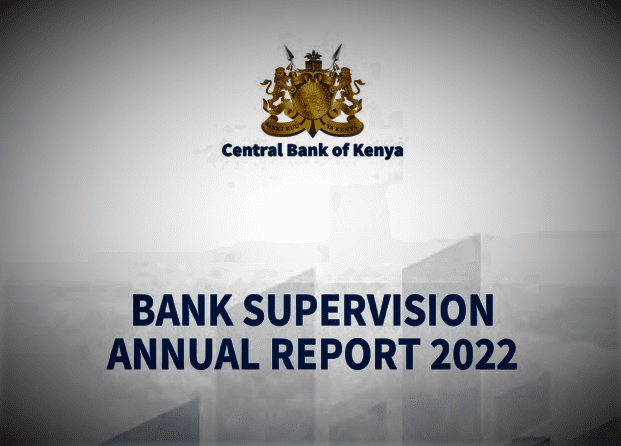Kenya’s Banking Sector recorded a 22% increase in pre-tax profit to KSh 249.4 billion in 2022 from KSh 197.0 billion in 2021.
According to the latest Bank Supervision Annual Report 2022 published by the Central Bank of Kenya(CBK), this rise in profitability was attributed to an 18.2% increase in total income compared to 16.5% in total expenses.
This annual CBK report highlights the structure of the Kenyan banking sector, supervisory developments, macroeconomic conditions, banking sector performance, regional and international development initiatives.
Profit before tax for Kenya’s Banking Industry increased by 22.0% to KSh240.4 billion from KSh197.0 billion in 2021. The increase in profitability was attributed to a higher increase in total income (18.2%) compared to an increase in total expenses (16.5%).
The Banking Sector’s Balance Sheet size grew by 10.0% to approximately KSh 6.6 trillion in 2022 from KSh6.0 trillion in 2021. This increase in total assets was mainly attributed to the growth in loans and advances.
The Sector recorded strong capitalization levels as a result of the retention of profits and additional capital injections. The sector’s capital adequacy ratio stood at 19.0% in 2022, a marginal decrease from 19.5% in 2021. Customer deposits increased by 7.0% from KSh4.5 trillion in December 2021 to KSh4.8 trillion in December 2022.
Gross loans increased by 11.5% from KSh 3,255.4 trillion in December 2021, to KSh 3,630.3 trillion in 2022. This growth in loans is attributed to increased demand for credit by Kenya’s various economic sectors.
The ratio of non-performing loans declined from 14.1% in December 2021, to 13.9% in December 2022. The marginal decline was majorly attributable to improved business activities as the economy continued to recover from the COVID-19 pandemic.
The number of Automated Teller Machines (ATMs) decreased by 65 (2.8%) to 2,301 in December 2022, from 2,366 in December 2021. The report attributes this decrease in ATMs in 2022, to the adoption of agency, mobile and digital banking in the banking industry.
In November 2022, CBK rolled out the Credit Repair Framework to commercial banks, mortgage finance companies and microfinance banks. The Framework sought to improve the credit standing of over 4.2 million mobile phone digital borrowers, whose loans were non-performing and had been reported as such to CRBs.
The majority of these borrowers were unable to repay their loans due to the adverse effects of COVID-19
The Industry’s Total deposits increased by 8.7% to KSh 5.0 trillion in December 2022, from Ksh.4.6 trillion in December 2021. The growth was supported by the mobilization of deposits through digital platforms.
The Microfinance sector registered a 4.8% decline in total assets in the year 2022. The total assets as of December 31, 2022, stood at KSh70.4 billion, in comparison to KSh73.9 billion reported in the year ended 2021. Net advances decreased by 1.9% from KSh 40.1 billion in 2021 to KSh39.3 billion in December 2022. The decline in loans was attributed to competition from commercial banks and digital lenders.
In its executive summary, this CBK Bank Supervision Annual Report notes that the Banking Sector encountered several challenges in 2022.
“On the global front, the year was characterized by multiple shocks including geopolitical conflicts, elevated commodity prices, high inflation, and the ravages of climate change. The Kenyan banking sector, however, remained stable and resilient, with a total capital adequacy ratio of 19.0% in December 2022 above the minimum capital adequacy ratio of 14.5%,” said Dr. Patrick Njoroge, CBK Governor.
He said Kenya’s banking sector entered 2022, on a strong footing as the economy fully reopened after the COVID-19 pandemic. Kenya’s economy continued to exhibit resilience underpinned by its diversity and sound macroeconomic policies.
The Annual Bank Supervision Report said that in 2022, several acquisitions were witnessed in the microfinance bank sector, including Branch International Limited (Branch) of Mauritius which acquired 84.89% shareholding of Century Microfinance Bank Limited (Century MFB).
Mauritius Holdings Limited (LOLC Mauritius) of Mauritius acquired 73% shareholding of Key Microfinance Bank PLC (Key MFB) while UMBA Inc. (UMBA) of State of Delaware, United States of America, acquired 66.06% shareholding of Daraja Microfinance Bank Limited (Daraja MFB.
The Central Bank of Kenya (Amendment) Act, 2021 on Digital Credit Providers (DCPs). became effective on December 23, 2021.
The principal objective of the Act is to empower CBK to supervise and regulate digital lenders to ensure a fair and non-discriminatory marketplace for access to credit.
This followed grave public concerns about unregulated Digital Credit Providers (DCPs) including the high cost of credit, unethical debt collection practices and abuse of personal data.
Subsequently, the Digital Credit Providers Regulations were published and operationalized on March 18, 2022. Accordingly, unregulated DCPs were required to apply for a license from CBK by September 17, 2022, or cease operations.
CBK has made significant progress on various fronts in improving and strengthening the Anti-Money Laundering and Combating the Financing of Terrorism (AML/CFT) Framework.
In July 2022, Kenya launched the Money Laundering and Terrorism Financing National Risk Assessment Report (NRA). The main objective of the NRA was to identify, understand and assess Kenya’s Money Laundering (ML) and Terrorism Financing (TF) risks at a national and sectoral level.
CBK supported the Taskforce as its Joint Secretary with the Financial Reporting Centre.
“The NRA report notes that Kenya has a relatively robust AML/CFT legal and institutional framework that is largely aligned to international standards. Additionally, it identifies some gaps in the framework,” said Gerald Nyaoma CBK Director, Bank Supervision Department.
In 2023, the CBK has planned several reforms and initiatives, including monitoring how banks are integrating climate-related and environmental risks when formulating and implementing their business strategy, governance, risk management and disclosure frameworks. Commercial banks are expected to commence climate-related risk disclosures by June 2023.
The CBK also intends to issue an Internal Liquidity Assessment Process (ILAAP) Guidance Note so as to strengthen liquidity in the Banking Sector. This note will enhance the existing liquidity risk management framework as well as mandate the adoption of the Liquidity Coverage Ratio and the Net Stable Funding Ratio by commercial banks in line with Basel III pronouncements.
ILAAP is an effective framework for liquidity risk management and will strengthen the liquidity resilience of banks and enable them to ride through liquidity shocks.
Dr Njoroge, the CBK Governor paints a grim picture in his 2023 Global Outlook.
“On the economic front, the global economy is expected to slow down. The weaker growth is attributed to a perilous phase of recovery. In this phase, economic growth remains low, financial risks have risen, while inflation remains high. Growth in Sub-Saharan Africa and on the domestic front is projected to remain moderate. On the whole, risks to the global economic outlook are heavily skewed to the downside,” said Dr Njoroge- the CBK Governor.





